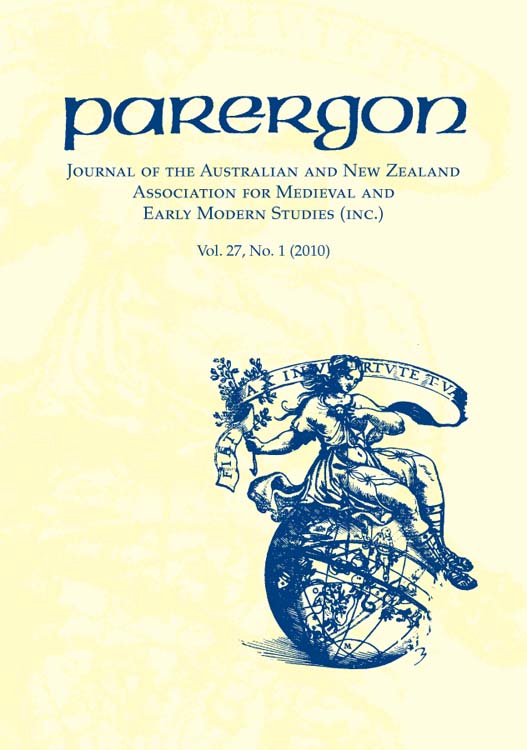
- Free Article: No
- Contents Category: Journal
- Review Article: Yes
- Online Only: No
- Custom Highlight Text:
Australian and New Zealand universities have for more than a century produced significant numbers of medieval and early modern literary scholars and historians. Formerly, full international recognition was won by many who moved to the northern hemisphere, but, happily, in these days of the global scholarly community, those who have chosen to make their careers at home are now accorded recognition and acclaim by their colleagues abroad. Parergon will next year celebrate its fortieth birthday; the journal’s belated coming of age is a tribute to a series of dedicated editors, the most recent being Anne M. Scott and Andrew Lynch at the University of Western Australia.
- Book 1 Title: Parergon, Vol. 26, No. 2
- Book 1 Biblio: UniPrint, $60.50 two issues p.a., ISSN 0313 6221
- Book 2 Title: Parergon, Vol. 27, No. 1
- Book 2 Biblio: UniPrint, $60.50 two issues p.a., ISSN 0313 6221
- Book 2 Cover Small (400 x 600):

- Book 2 Cover (800 x 1200):

- Book 2 Cover Path (no longer required): images/1_SocialMedia/2021/May_2021/cover_27_1.jpg
Parergon,begun under the editorship of J.C. Eade at the ANU English Department, was in its early years essentially the between-conferences voice of the Australian and New Zealand Association of Medieval and Renaissance Studies; then the studies were heavily slanted towards medieval literary texts, although this was to change as relations between associations of literary and historical studies became more collegial (there were some interesting border skirmishes along the way). By the late 1990s, ANZAMRS and a cluster of similarly antipodean-acronymed historians’ groups had become ANZAMEMS, partly as the result of international shifts towards interdisciplinary study and of much-needed interrogations of what the very concept of ‘period’ might denote. Changes to the university culture in general had for several years encouraged greater international travel and conference participation, so that the predominantly parochial character (no disrespect is implied here) of local specialist journals began to change. Just as Australian and New Zealand scholars published their work in northern hemisphere serials, so too colleagues overseas have come to recognise the worth of our own journals. Lilliputian voices – many of them very powerful – these days have access to the discourses of the Internet. Strengthened recently by participation in the ARC Network for Early European Research, scholarly essays and reviews published in Parergon have since 2005 reached an international readership courtesy of the journal’s affiliation with Project Muse, a highly useful database of some four hundred online journals representing all aspects of the humanities and social sciences.
One of the issues under review (Volume 26, Number 2) is on the theme ‘Friendship in Early Modern Philosophy and Science’, and is guest-edited by Vanessa Smith and Richard Yeo. Including a necessarily shortened series of the book reviews for which Parergon is to be commended, it illustrates the seriousness of the journal’s commitment to interdisciplinary research. All six essays reference classical theories of friendship: chronologically arranged, they move from John Locke on ‘Conversation’, through Margaret Cavendish’s Philosophical Letters and the slightly later A Serious Proposal to the Ladies by the Anglican-Tory proto-feminist Mary Astell, to the collaborative friendship between the philosopher–scientists RobertSouthwell and VincenzioViviani, to eighteenth-century ‘bluestocking’ friendships and an account of Joseph Banks’s relationships with Oceanic cultural informants. The quality of argument and research is uniformly high. Of special interest is Elizabeth Eger’s fascinating account of the material emblems of ‘blues’ cultural exchange. The redoubtable botanical illustrator Mary Delany instigated an art form through her exquisitely accurate ‘paper mosaics’, some of which are illustrated in the essay. Mrs Delany’s work was highly valued by the young Joseph Banks, whose friendships with two very different Oceanians, Tupaia and Mai, are analysed by Vanessa Smith in an article which sheds new light on the discourse of imperial encounter.
Volume 27, Number 1, a standard Parergon issue, covers a vast terrain in terms of chronology, subject, and methodology; the authors and texts discussed range from the seventh to the seventeenth centuries, but some of the critiques have strong contemporary frames: for example, Antonina Harbus’s account of Anglo-Saxon mentalities, and Helen Young’s stimulating entry to ‘medievalism’ through contemporary fantasy fiction. Paul Salzman’s distinguished contributions to the field of seventeenth-century women’s writing continue in a fine essay on the indefatigable Anne Clifford, which forms a companion piece to the essays on women in the ‘Friendship’ issue. John Gascoigne’s ‘Pacific Exploration as Religious Critique’, which centres on JohnHawkesworth’s travelogues, sent this reader back to Vanessa Smith’s work on Joseph Banks.
Conal Condren’s witty excursion into the little-documented ‘Prehistory’ of ANZAMEMS (Inc.), which introduces the volume, is more than a sentimental journey; this kind of institutional history is valuable as a means of charting the vast changes which have taken place in Humanities departments over the decades since this journal began. A new generation of medievalists and early modernists, one suspects, would have to exercise its historical imagination to understand the kind of conferences which provided Parergon with its earliest contributions – ‘keynote’ addresses reserved for (sometimes) illustrious visitors from the northern hemisphere, no parallel sessions, and the opportunity to go beyond the fifteen minute sound bite. There have been losses, along with the undisputed gains brought by global conferencing.
The online future of Parergon as a high-quality refereed publication, thankfully, seems assured. It is to be hoped that it will continue to be disseminated in hard-copy. Present and future editors might consider the present print format of the journal, which is somewhat at odds with the standard of its contents. A shift from footnotes to endnotes, which might be regarded as heresy by some, would have the advantage of offering a more readable page. So too would wider margins, and a more distinctive setting of title and author names at the head of essays. But these are mere quibbles. May Parergon (the name refers modestly to a text which is complementary or auxiliary to a larger opus, reminding the scholar of his or her proper place) still have shelf space forty years hence.


Comments powered by CComment